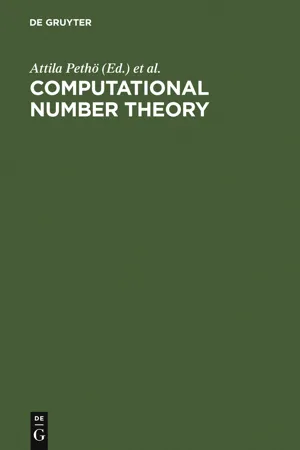
This is a test
- 355 pages
- English
- PDF
- Available on iOS & Android
eBook - PDF
Computational Number Theory
Book details
Table of contents
Citations
Frequently asked questions
At the moment all of our mobile-responsive ePub books are available to download via the app. Most of our PDFs are also available to download and we're working on making the final remaining ones downloadable now. Learn more here.
Both plans give you full access to the library and all of Perlego’s features. The only differences are the price and subscription period: With the annual plan you’ll save around 30% compared to 12 months on the monthly plan.
We are an online textbook subscription service, where you can get access to an entire online library for less than the price of a single book per month. With over 1 million books across 1000+ topics, we’ve got you covered! Learn more here.
Look out for the read-aloud symbol on your next book to see if you can listen to it. The read-aloud tool reads text aloud for you, highlighting the text as it is being read. You can pause it, speed it up and slow it down. Learn more here.
Yes, you can access Computational Number Theory by Attila Pethoe, Michael Pohst, Hugh C. Williams, Horst G. Zimmer in PDF and/or ePUB format, as well as other popular books in Matematica & Matematica generale. We have over one million books available in our catalogue for you to explore.
Information
Table of contents
- Preface
- List of contributors
- Table of contents
- On the construction of primitive elements and primitive normal bases in a finite field
- A numerical method for the determination of the cyclotomic polynomial coefficients
- Number systems
- Fast converging series representations of real numbers and their implementations in digital processing
- On a polynomial transformation and its application to the construction of a public key cryptosystem
- Number-theoretic transforms and a theorem of Sylvester-Kronecker- Zsigmondy
- A probabilistic class group and regulator algorithm and its implementation
- Prime-producing quadratic polynomials and class numbers of quadratic orders
- Applications of a new class number two criterion for real quadratic fields
- On a solution of a class number two problem for a family of real quadratic fields
- Cubic number fields with exceptional units
- Enumeration of totally complex quartic fields of small discriminant
- Class number computation by cyclotomic or elliptic units
- Computing fundamental units from independent units
- A note on index divisors
- Computation of independent units in number fields by a combination of the methods of Buchmann / Pethö and Pohst / Zassenhaus
- Hecke actions on classes of ternary quadratic forms
- Computation of singular moduli by multi-valued modular equations
- Congruent numbers and elliptic curves
- The rank of elliptic curves upon quadratic extension
- On the resolution of some diophantine equations
- Index form equations in cubic number fields
- On the practical solution of the Thue-Mahler equation
- Some results on Thue equations and Thue-Mahler equations
- On the solution of the diophantine equation Gn = P(x) with sieve algorithm
- On Thue equations associated with certain quartic number fields
- KANT - a tool for computations in algebraic number fields
- SIMATH - a computer algebra system